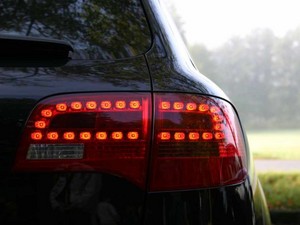Traditional taillights use light bulbs, which produce a continuous beam of incandescent light. The light is produced when electric power passes through a resistive filament, producing sufficient heat that the filament becomes “white-hot.” LEDs, or light emitting diodes, are semiconductor devices and not light bulbs, though they do give off light through atomic transitions. Power (considerably less than that needed for light bulbs) is provided to the semi-conductor device, which then gives off light, but very little heat.
Advantage of LEDs – Brake Time
Semi-conductor devices are like switches. Throw the switch, and power comes on pretty nearly instantly. Light bulbs receiver power just as quickly, but it takes time to heat the filament to white-heat, so light appears more slowly. Although the difference is only a fraction of a second, in a taillight of a vehicle trying to avoid an accident, it can make an important difference. The driver of the car has that amount of time more to apply his brakes, and the car has that much more time to slow down and stop. So rapidity of response is a real advantage of LED taillights. In fact, Cadillac estimates that at a speed of 60 mph, the difference is 17.6 feet of travel time.
Advantage of LEDs – Lifetime
Not having heated filaments to burn out, the life expectancy of LEDs is considerably higher. Some LEDs even last for decades. In addition, since very little heat is produced by LEDs, efficiency is greatly improved. Since a taillight is made up of many LEDs, it is very unlikely the entire taillight will ever burn out. Which is a good thing from a safety perspective, but also from that of…
Cost – A Decided LED Disadvantage
LED taillights, per pair, can easily cost well over $100. Some brands can cost $300 – $400 and more! Most likely these costs will drop considerably as mass manufacturing techniques improve. Since they do not burn out as fast, however, manufactures may not be in too big a hurry to lower prices.
Flickering and Increased Brightness – a Safety Problem?
The website Fun-LED-Light discusses a problem noticed by the author, that of distraction. The site says, “When you try looking at a bunch of tail light LEDs…your eye will be strongly attracted to the light-you will see a kind of a strobing effect through the involuntary saccadic movement of your eyes.” An additional complaint is that some LED taillights are annoyingly bright. LEDs that are much brighter than those used as taillights are a potential safety hazard. Will any of these three difficulties prove to be a safety hazard as well? Doubtless time will provide the answer to that question.
References and Resources:
U.S. Department of Energy – Energy Efficiency & Renewable Energy
Ask Cars – What are LED taillights?
For More Advanced Readers:
Washington University in St. Louis, Department of Chemistry – “Bands, Bonds, & Doping: How Do LEDs Work?”





